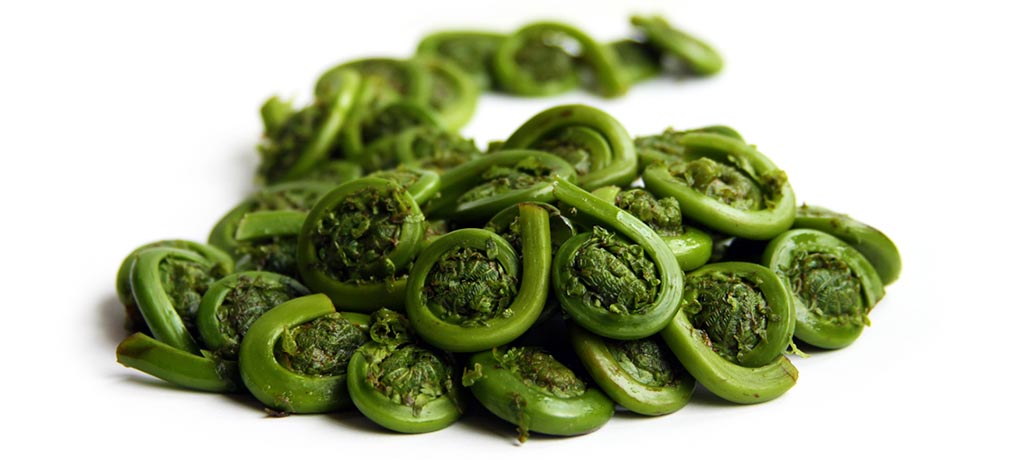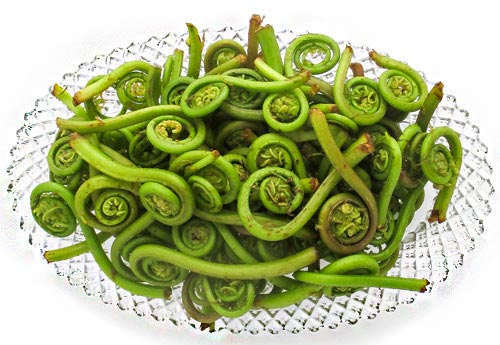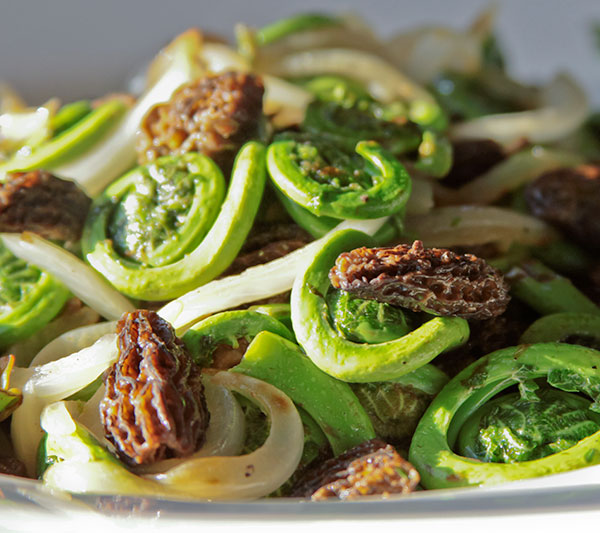Fiddlehead Ferns
Fresh fiddleheads are the premium wild forage vegetable of spring. No other vegetable, wild or cultivated, matches the exquisite form and delicious flavor of fresh fiddleheads.
The Eastern Fiddlehead Fern: Ostrich Fern (Matteuccia struthiopteris)
Fiddleheads emerge in their miniature dervish dancers around the first week of May. In lowland forests from the Great Lakes to the Maritimes of Canada the Ostrich Fern emerges in profusion. Tiny gray-green spirals reaching into the first really warm days of Spring. Each of them wearing their own little fur overcoat to protect them when it was chillier weather. Snapped up and eaten by whoever has the sense and taste to do it.
By Summer the ferns will be up 4 feet tall thick even after our feast. The clean lowlands of Nova Scotia and along the East Coast of the United States have been successfully managed for commercial harvest for more than 200 years. They are wild lands but for the harvest each Spring.
The Western Fiddlehead Fern: Lady Fern (Athyrium filix-femina)
Most people think only of the Eastern Fiddlehead, the Ostrich fern when they think of edible fiddleheads. But there is another widely consumed wild fern, the lady fern. The lady fern is a primarily a Western fern variety with growing ranges from California to Alaska, although they have been reported to be found growing in eastern Canada. Lady fern fiddleheads, often referred to simply as “western fiddleheads,” are less popular than the Eastern ostrich fern fiddleheads because of the slightly bitter flavor that they sometimes have – especially when not prepared properly.
The texture of the western fiddlehead is crunchy and juicy. The flavor of fiddleheads is strongly grassy and woodsy with a pronounced tannic (occasionally astringent) finish. But with proper cooking, the flavor of western fiddleheads develops fully and the bitter tannic finish dissipates.
Selection
Good fiddleheads should have a distinctly crisp texture, both before and after cooking. When selecting fiddleheads, look for a tight coil with an inch or two of stem beyond the coil. There is a brown papery chaff that surrounds the fiddlehead on the plant. Most of this will probably have been removed prior to purchase, but some may remain. The outside of the coil should have an intricate pattern of tiny leaves arranged along the sides of the spiral. Size of the coil should be 1 to 1.5 inches in diameter. Larger size is acceptable as long as they are tightly coiled.
Know what you are picking! There are many varieties of wild ferns and very few of them are edible. The common bracken fern and other species of ferns also produce tightly coiled new growth in the spring, but none of these are suitable for eating.
Cleaning & Storage of Fiddleheads
If you pick fresh fiddleheads yourself, you will want to give them a good cleaning. If more than 2 inches of stem remains attached beyond the coiled part of the fiddlehead snap or cut it off. If any of the papery chaff remains on the fiddleheads, just rub it off by hand. Since the chaff is very lightweight, you can clean fiddleheads outdoors by fanning them or lightly shaking them in an open wire salad basket. The chaff will simply blow away!
After the chaff is removed, wash the fiddleheads thoroughly in a couple of changes of cold water to remove any dirt or grit. Drain the fiddleheads completely and place them in plastic bags for storage in the refrigerator, or use them immediately.
Once cleaned, fresh fiddleheads store well. Keep them in a cold zone of the refrigerator (35 F) and tightly sealed in a plastic bag to avoid them drying out. Fresh fiddleheads are full of tannins (like tea) and may exude a dark brown watery liquid. This is normal. Just give them a quick rinse in fresh water and, If you wish, trim the tip of the stem just before before cooking. They may be kept in the refrigerator for up to two weeks, although the wild flavor of fresh fiddleheads will always be best when used as soon as possible after harvest.
Cooking Fiddleheads
Fresh fiddleheads should ALWAYS be cooked. Fiddleheads should not be served raw as they have a slight bitterness until cooked and may cause stomach upset if eaten raw in quantity.
Fiddleheads are extremely versatile and easy to use. They have a wild-yet-mild taste, which has been often compared to a mix of of asparagus, artichokes and green peas. But their flavor is unique, and is distinctly its own. Use fiddleheads much like any firm green vegetable, such as asparagus or broccoli florets, both on their own as a featured vegetable, or in combination with other ingredients. However you use them, the pleasant flavor of fiddleheads will appeal to even the most finicky and demanding palate. Fiddleheads will lend their delicious flavor and elegant visual appeal to many familiar dishes.
Basic preparation
Before enjoying any variety of fiddlehead, they must first be blanched. Rinse the fiddleheads under cold running water to remove any bits of chaff or debris. Trim the ends to remove any discolored parts, if desired. Cook for 1 – 2 minutes in a large pot of rapidly boiling, salted water. Drain the fiddleheads and quickly plunge into cold water to retain their crisp texture and to prevent overcooking. Do not overcook!
Blanched fiddleheads can be finished in any number of ways, but one of the simplest (and best) methods is to saute them in butter for a few minutes. Finish with a pinch of salt and a dash of pepper. Their wild, green spring-like flavor will shine through. Blanched fiddleheads may also be marinated or pickled, used in salads, soups, stir frys and casseroles. Pair them with other spring delicacies, such as morel mushrooms or ramps (wild leeks).
The flavor of fiddleheads goes well with many mainstream ingredients and in many traditional recipes from around the world. Fiddleheads are wonderful in pasta dishes, and their mild flavor goes well with cheeses, tomato-based sauces. Not surprisingly, fiddleheads are excellent when served with Hollandaise sauce! Fiddleheads are a natural in Asian recipes. Use them as the main vegetable in a simple stir-fry or combine them with other Asian ingredients.



